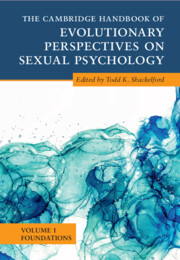Book contents
- The Cambridge Handbook of Evolutionary Perspectives on Sexual Psychology
- The Cambridge Handbook of Evolutionary Perspectives on Sexual Psychology
- Copyright page
- Contents
- Contributors
- Preface
- Part I Foundations of Evolution
- Part II Middle-Level Theories
- 7 Parental Investment Theory
- 8 Parent–Offspring Conflict
- 9 Theory and Evidence for Reciprocal Altruism
- 10 Life History Theory and Mating Strategies
- 11 Sperm Competition Theory
- 12 Sexual Conflict Theory
- 13 Cross-Species Comparisons
- 14 Cross-Cultural Methods in Sexual Psychology
- 15 Behavioral Genetics
- 16 Sex Differences and Sex Similarities
- 17 Individual Differences in Sexual Psychology
- 18 Experimental Methods in Sexual Psychology
- Index
- References
15 - Behavioral Genetics
from Part II - Middle-Level Theories
Published online by Cambridge University Press: 30 June 2022
- The Cambridge Handbook of Evolutionary Perspectives on Sexual Psychology
- The Cambridge Handbook of Evolutionary Perspectives on Sexual Psychology
- Copyright page
- Contents
- Contributors
- Preface
- Part I Foundations of Evolution
- Part II Middle-Level Theories
- 7 Parental Investment Theory
- 8 Parent–Offspring Conflict
- 9 Theory and Evidence for Reciprocal Altruism
- 10 Life History Theory and Mating Strategies
- 11 Sperm Competition Theory
- 12 Sexual Conflict Theory
- 13 Cross-Species Comparisons
- 14 Cross-Cultural Methods in Sexual Psychology
- 15 Behavioral Genetics
- 16 Sex Differences and Sex Similarities
- 17 Individual Differences in Sexual Psychology
- 18 Experimental Methods in Sexual Psychology
- Index
- References
Summary
In this introductory chapter, we discuss the nexus between evolutionary theory and behavioral genetics, using it to elucidate the biological origins of human behavior and motivational predispositions. We introduce relevant behavioral genetics methods and evolutionary theoretical background to provide readers with the necessary conceptual tools to deepen their engagement with evolutionary behavioral genetics – as well as to help them take on the challenge of building a scientifically and evolutionarily more consilient account of human behavior. To demonstrate the utility of behavioral genetics in evolutionary behavioral science, our analytical examples range from personality, cognition, and sexual orientation to pair-bonding. We conclude by presenting a few recent landmark studies in behavioral genetics research with a particular focus on two aspects of sexual behavior: assortative mating and same-sex sexual behavior. This chapter considers behavioral genetics methods and their connection with evolutionary science more broadly while providing a succinct overview of recent advances in understanding the evolutionary genetic underpinnings of human sexual behavior, mate choice, and basic motivational processes. It is a sine qua non of scientifically principled evolutionary behavioral scientists to acknowledge the distal evolutionary and proximal genetic processes which, interlinked, underlie the psychobehavioral predispositions that form the variegated fabric of human societies and, more broadly, the diversity of life found in nature. These evolutionary processes operate from distal selection pressures acting on genetic material through hundreds of millions of years of natural selection –and from individual and population differences in genotypes to their manifestations in complex behavioral phenotypes and life outcomes in contemporary humans – which, in turn, enact concomitant selection pressures on the genetic material underlying and arising from them.
- Type
- Chapter
- Information
- Publisher: Cambridge University PressPrint publication year: 2022
References
- 2
- Cited by



